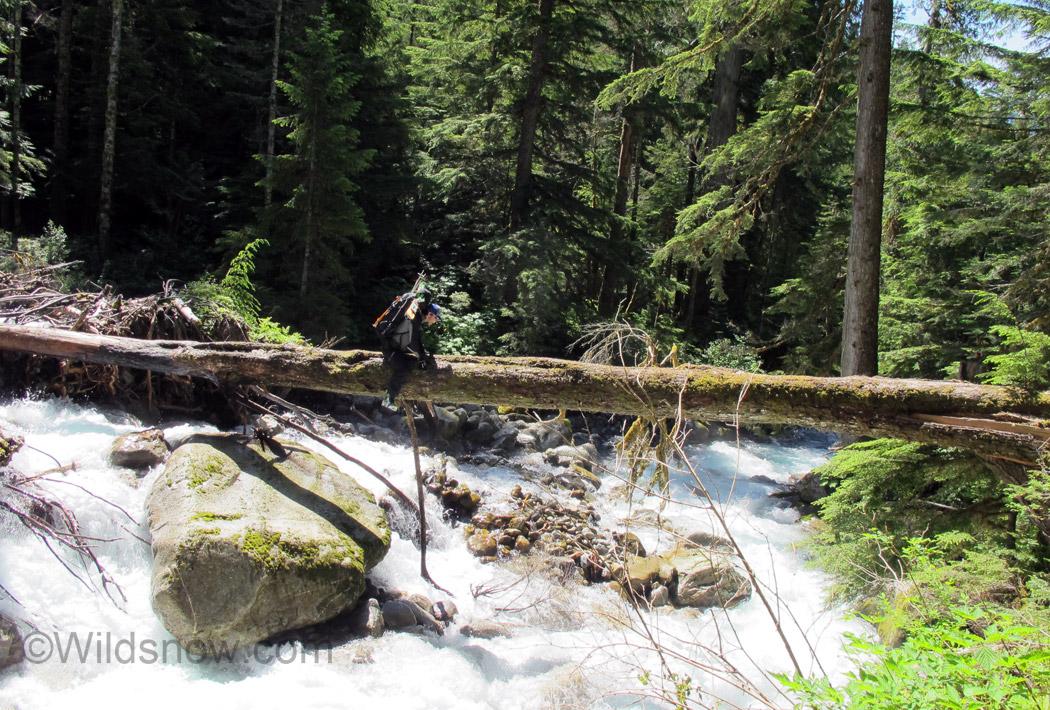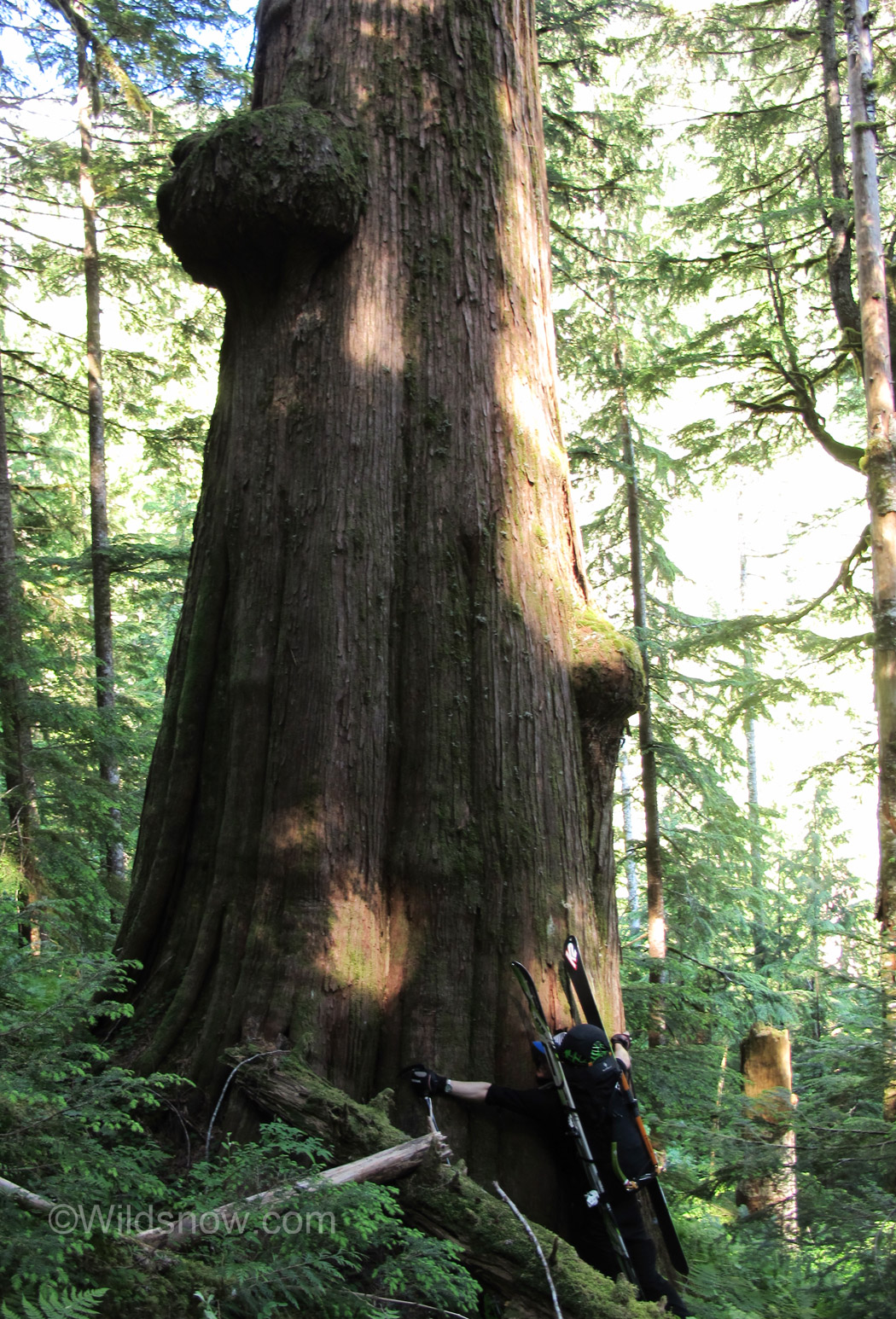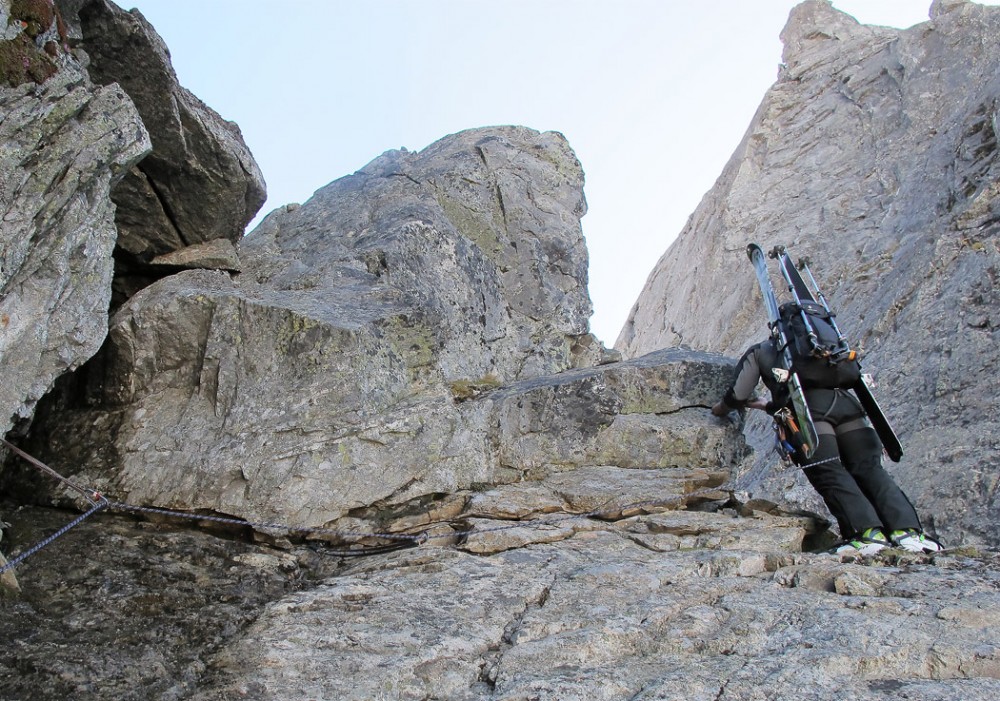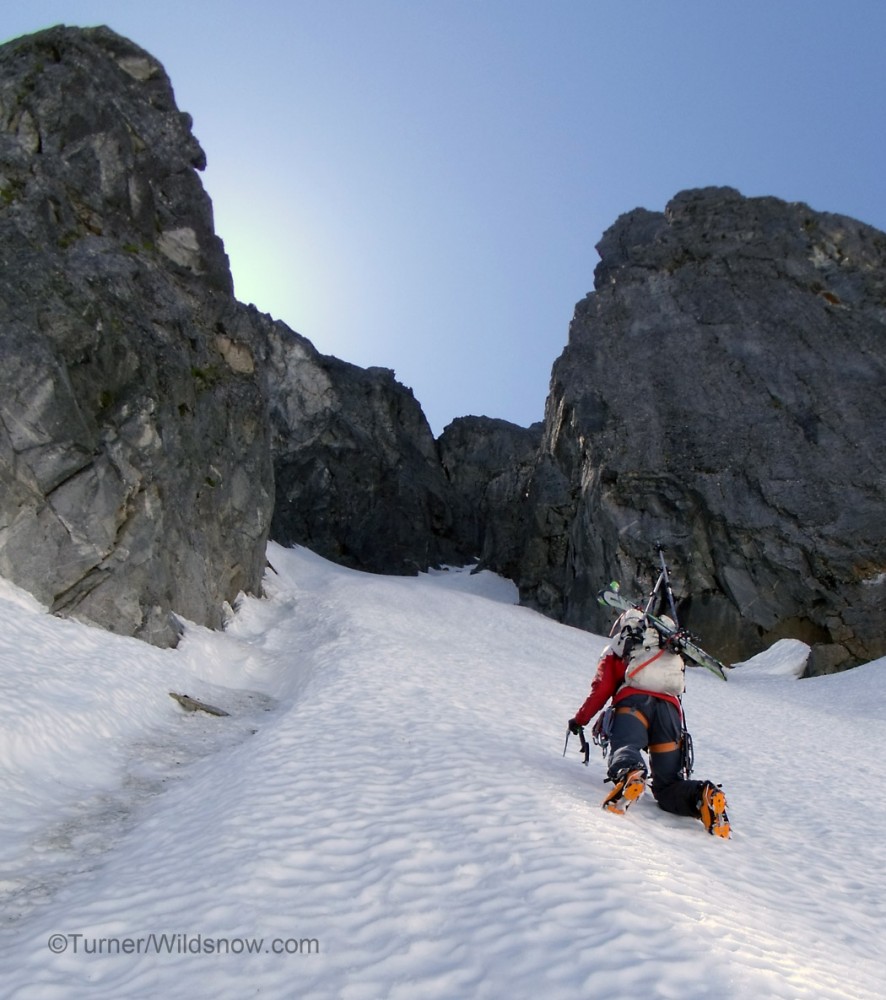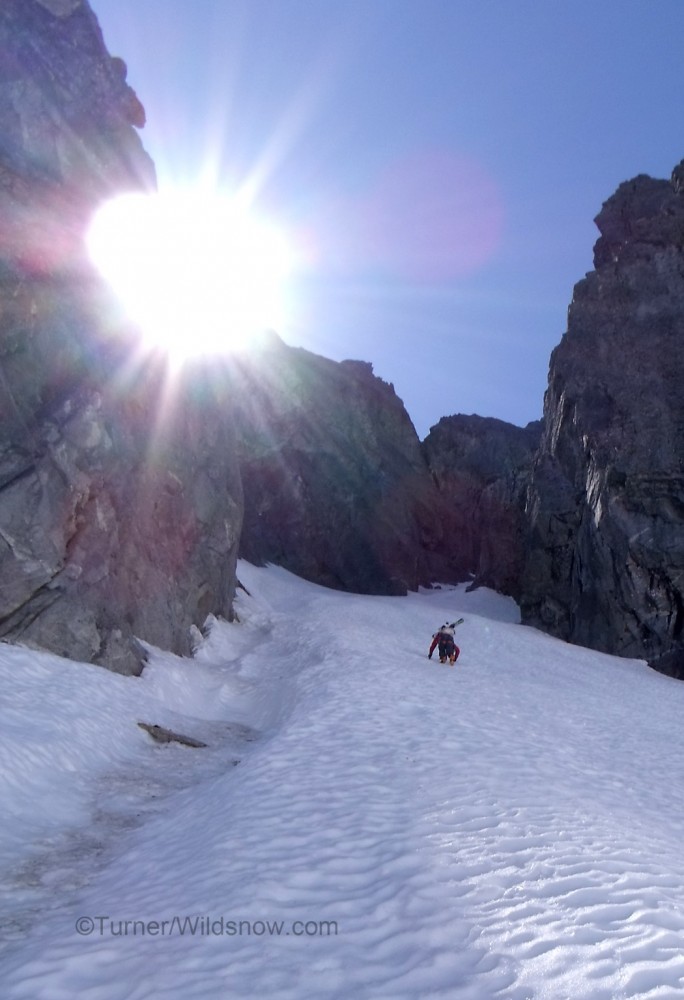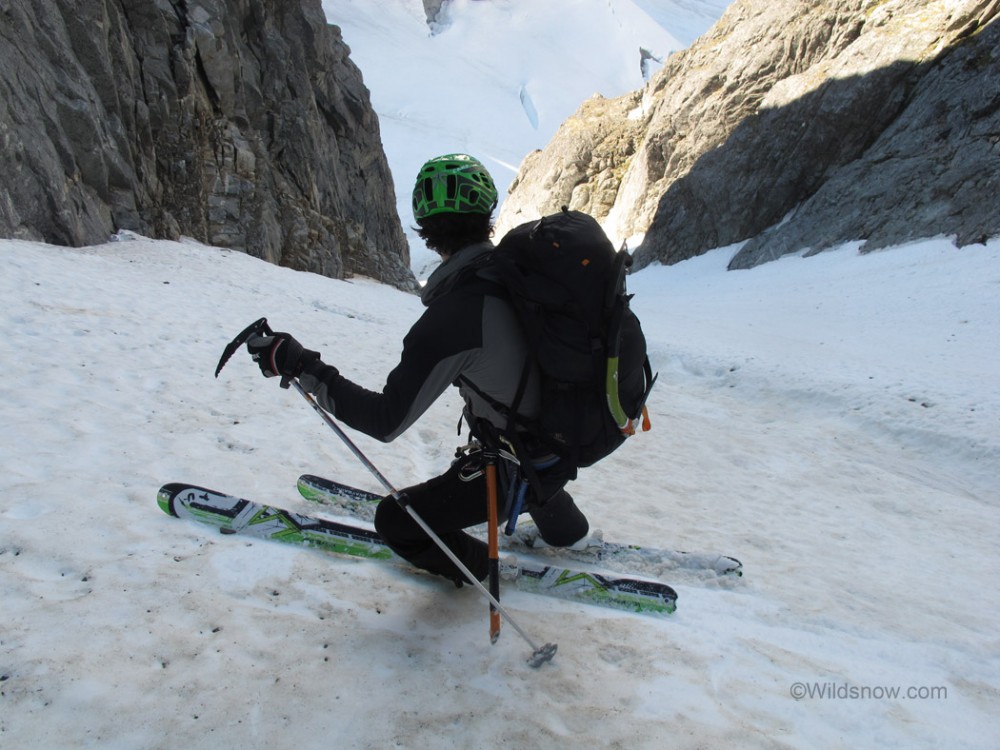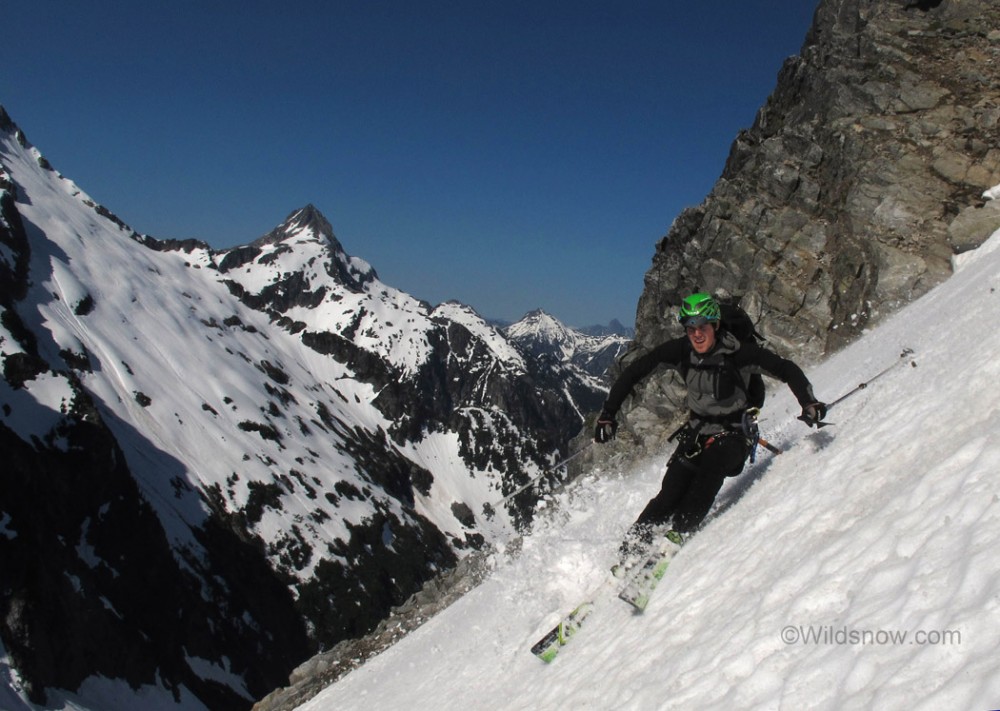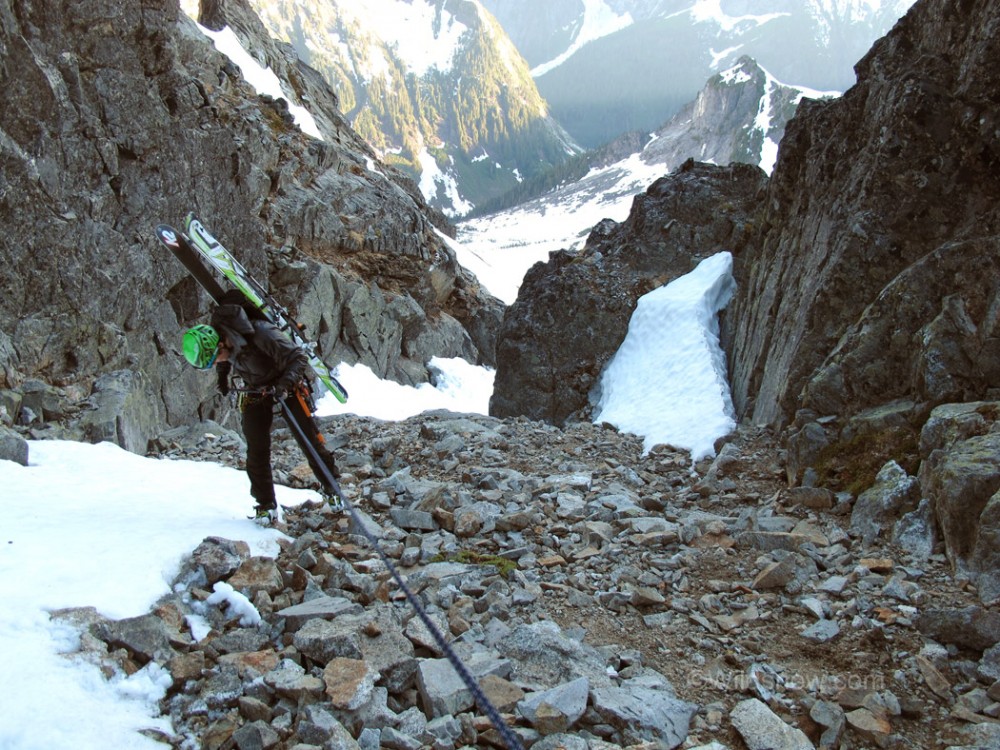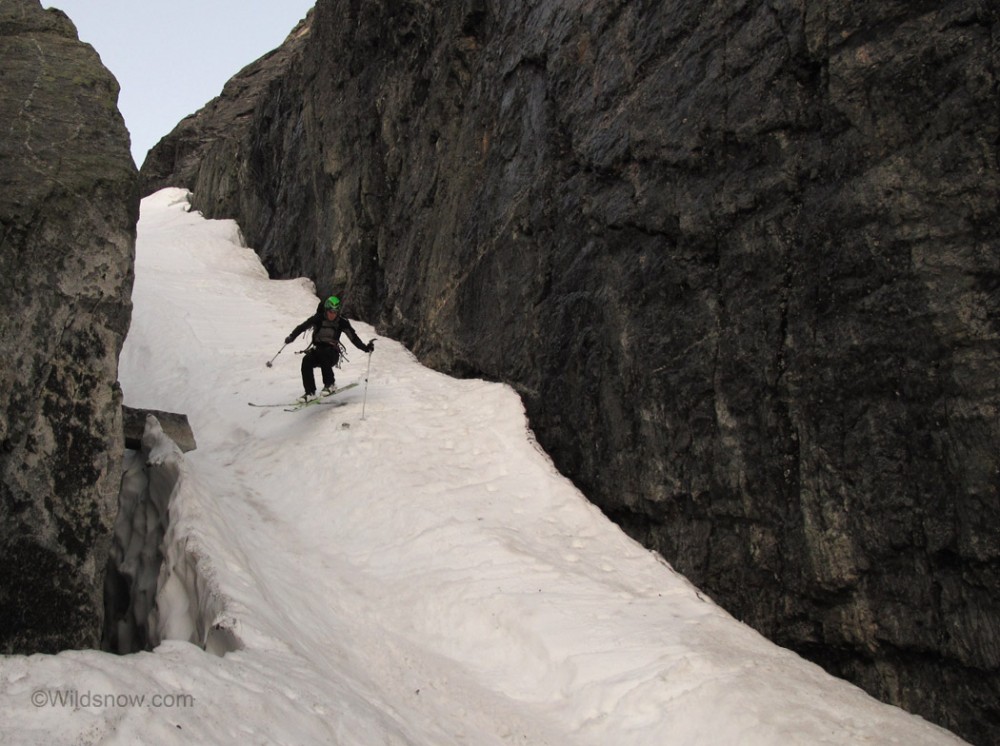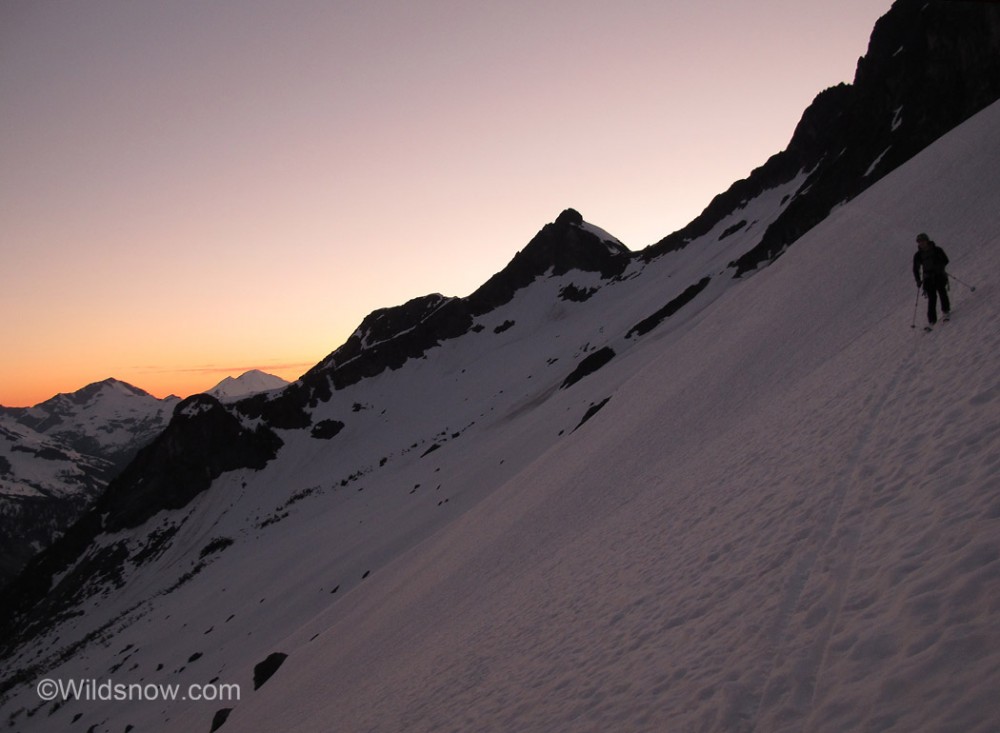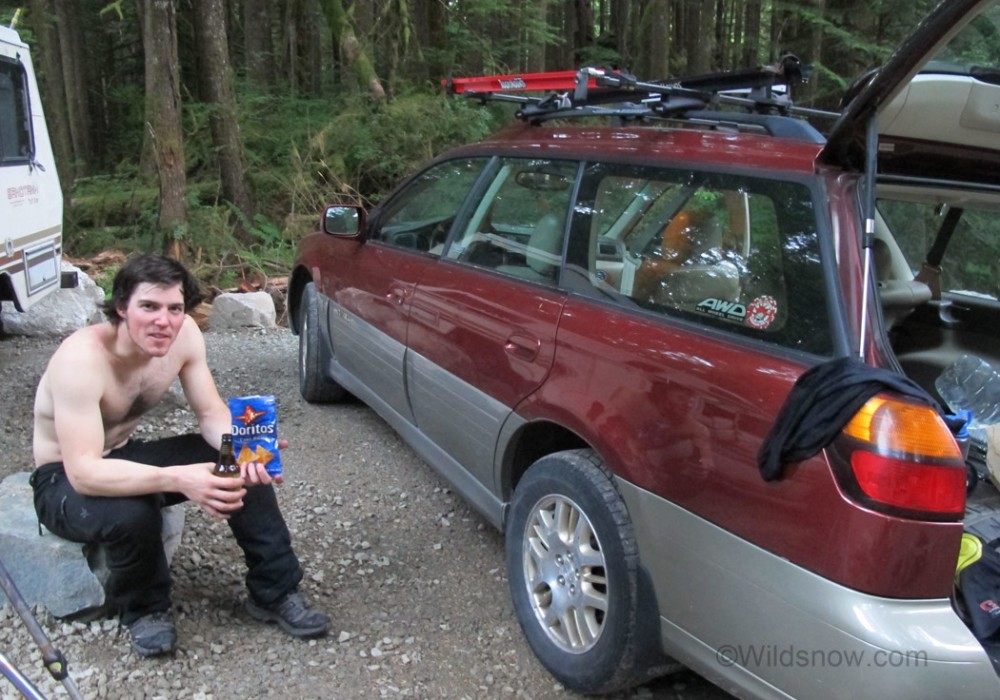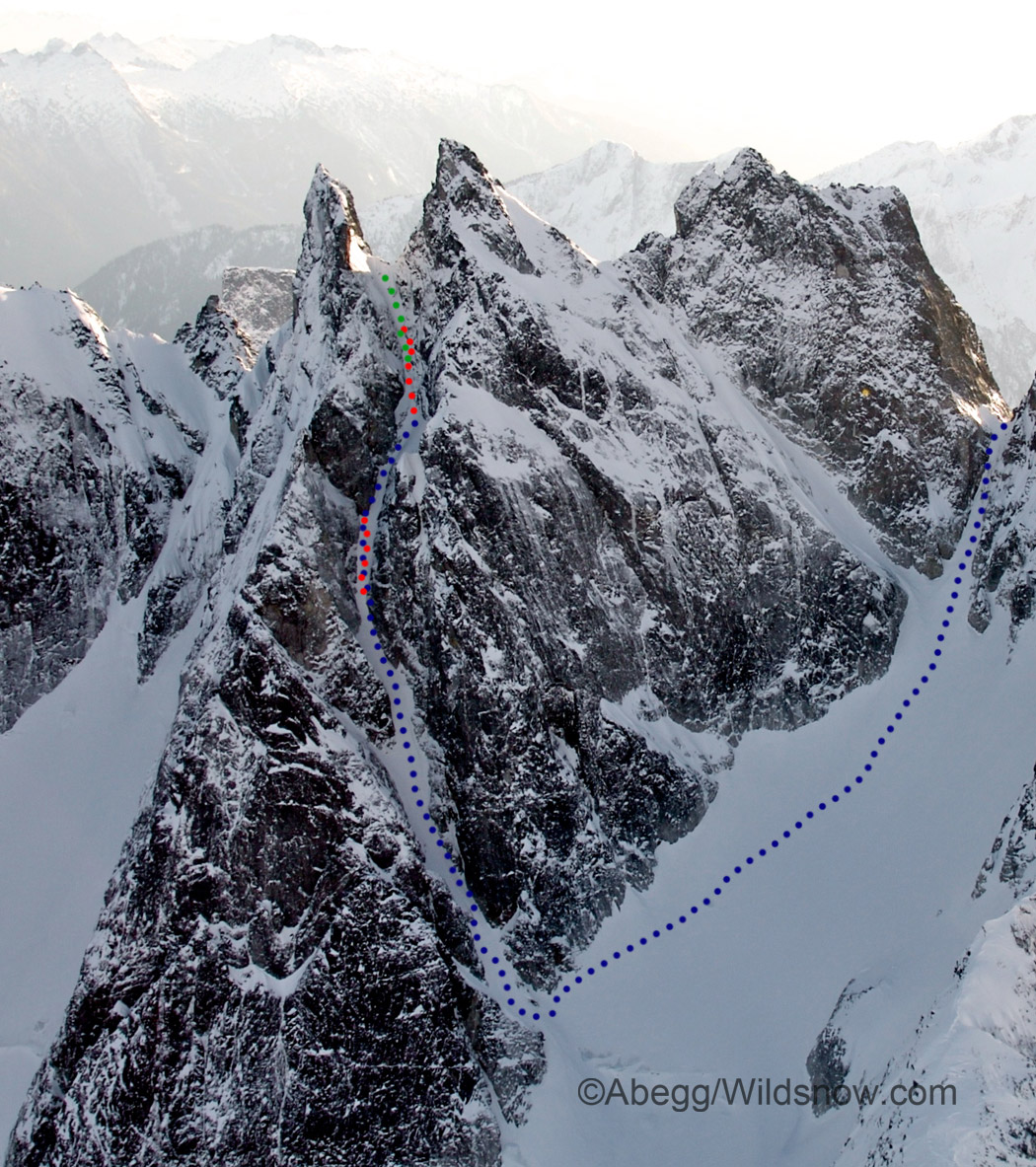
The Twin Needles in December 2008. The Thread of Ice is the obvious coulior on the right, and Otto-Himmel Col is on the far left. Blue is our ski route, red is rappels, green is belayed skiing. Where colors overlap is where one of us rappelled. Photo by Steph Abegg.
We get it all in this trip report: youthful spirit, great images, and some vision. Two skiers enter Washington’s remote Picket Range to ski Thread of Ice.
Editor’s Note: This trip report first ran on WildSnow in 2011. Consider it some early-season inspiration if you are already dreaming up potential springtime trips.
The list. Every skier has one, whether they know it or not. Stuff you want to make turns down. Places you want to travel. Some of it is realistic; some not so much.
My list is long. It’s been the reason behind a great many unsuccessful backcountry trips and a few successful ones. One way I add things to my list is by trawling through John Scurlock’s website. Scurlock flies around the North Cascades in his home-built plane and takes tons of incredibly beautiful aerial photographs. Lots of his pics are taken during winter and in places that not many people get to, so his images are an unparalleled way to scout ski lines. Thread of Ice was one of many couloirs I spied that looked amazing, but also very steep and possibly unskiable.
Eventually, I found the trip report of Steph Abegg’s first ascent of the Thread of Ice, back in 2009. She mentioned in her TR that it would make a “challenging ski descent.” That convinced me I needed to check it out at some point, especially since it is in the legendary Pickets. The Pickets are a small mountain range in the North Cascades, well known for incredible alpine climbing — and a few (though potentially many more) hairy ski descents. What is perhaps more well known is the approach, a full day of bushwacking through the densest of PNW jungles.
My friends and I have made plans for a few Picket trips over the past two years, but they always got shut down for various reasons, mostly weather. I was excited when a potentially perfect weather window lined up with some days I had off, and Kirk sent me an email wanting to take advantage of it as well. It seemed like the perfect time to give a run at the Thread of Ice.
I had stared at trip reports and route descriptions so much I could practically recite them from memory. Nonetheless, I printed out as much info as possible. Hopefully, tilting the odds in our favor for the upcoming battle with the Washington underbrush. While we wanted enough technical gear for the rugged alpine of the Pickets, we also tried to keep our pack weight down for the vertical moss climbing on the approach. We each took one technical tool, one axe, and two whippets. We grabbed a 60-meter 8mil rope and a miniscule rock rack. After purging what unnecessary items I could from my pack, it still ended up feeling pretty heavy, especially when loaded down with boots and skis. I used my incredible Cilogear 75-liter ruck on this trip, and I’m ashamed to say it was filled to the brim.
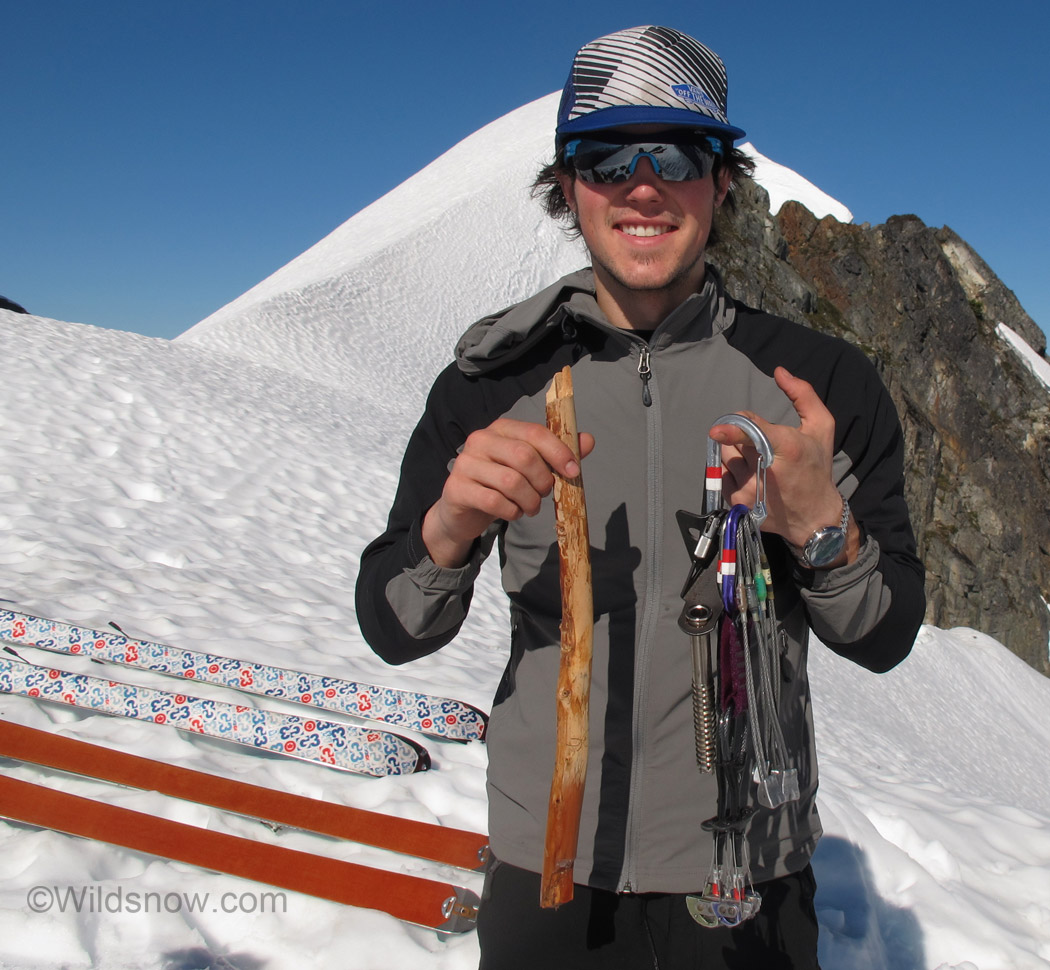
All the gear you need to climb in the Pickets! Our “rack” consisted of 2 cams, 5 nuts, one piton, as well as two sticks we picked up on the way in for use as deadmen. In retrospect it would have been smarter to take a bit more gear, but it’s amazing how many anchors you can build with a minimal amount of gear, with a little ingenuity and low standards.
We left Bellingham around 5:00 am and found the trailhead at about 6:45. After a bit of walking around to find the trail, we set off at 7:15. The first few miles were a fairly well-used trail, with only two stream crossings that took a few minutes. At the end of the old road bed, we turned off the well-used path and continued straight through the woods for a bit. I was elated, as I hadn’t expected the going to be this easy. We encountered some thicker bush in the woods, and it took us a little while to reach Terror Creek, the major stream crossing. The creek was running high; the only way across was a long log bridging the water about 15 feet above. My elation was short-lived, as the scary-log-shimmy was only the beginning of some of the most challenging off-trail “hiking” I’ve ever done.
On the other side of Terror Creek, we spent a few minutes looking for the faint trail and did find something that was, on occasion, slightly better than a full-on crawl. From this point, the route continues 1,700 feet straight up to the top of the ridge. The slope has numerous small cliffs, and if you lose the trail, you are likely to get cliffed out. We slowly clawed our way up roots, carefully staying on the faint “trail” when we could. Whippets proved to be indispensable for near vertical vegetation.
The heat rose as we climbed the hill, and we finally reached the ridge crest. The angle lessened, the underbrush thinned, and we were able to speed up a bit. A few hours more and we finally reached snow line. We skinned slowly up the snowfield below the Chopping Block, and reached our campsite. We expected to be sleeping on rocks, but none were in sight. We flattened out a spot on the ridge, began drying our gear, and enjoying the views in the remaining sun.
Into the Alpine
We went to bed early that night and woke up at 5:00 to attempt the Thread of Ice. After a quick breakfast and snow melt, we skied down to Crescent Creek basin. It was warm, and the snow hadn’t frozen completely, making nice turns. We were able to traverse much of the basin before switching to booting and heading up toward Otto-Himmel col. We booted up most of the way, before encountering a small rock band blocking the couloir. The rock band was only about 10 feet high, however, it also had a 10-15 foot deep moat in front of it that blocked our way like a vicious river. We decided to head back down the chute for a little bit and try a third-class gully that had branched off to the side. We headed up the loose gully a few hundred feet until it started turning into 5th-class terrain.
We built an anchor, and Kirk started up the wet slab towards an overhang. I was glad to be belaying, as Kirk’s skis caught on the overhang above, and his cramponed ski boots scraped on the wet slab below. He banged in a marginal piton and blindly plugged his one cam into a flared crack. Nice lead! Finally, he got a solid hook on a ledge above and moved on to easier terrain and better protection. I followed, and we booted up the rest of the couloir to Otto-Himmel col.
We were excited to see what the other side of the col had in store; good skiing, we hoped. Our work was rewarded, and a nice 1,000-foot run stretched before us. We found an old stuff sack full of expired food in the rocks and couldn’t resist grabbing a few free calories the marmots had left for us. After a short break, we made turns down the steep couloir and down the wide-open glacier to the base of the Thread of Ice.
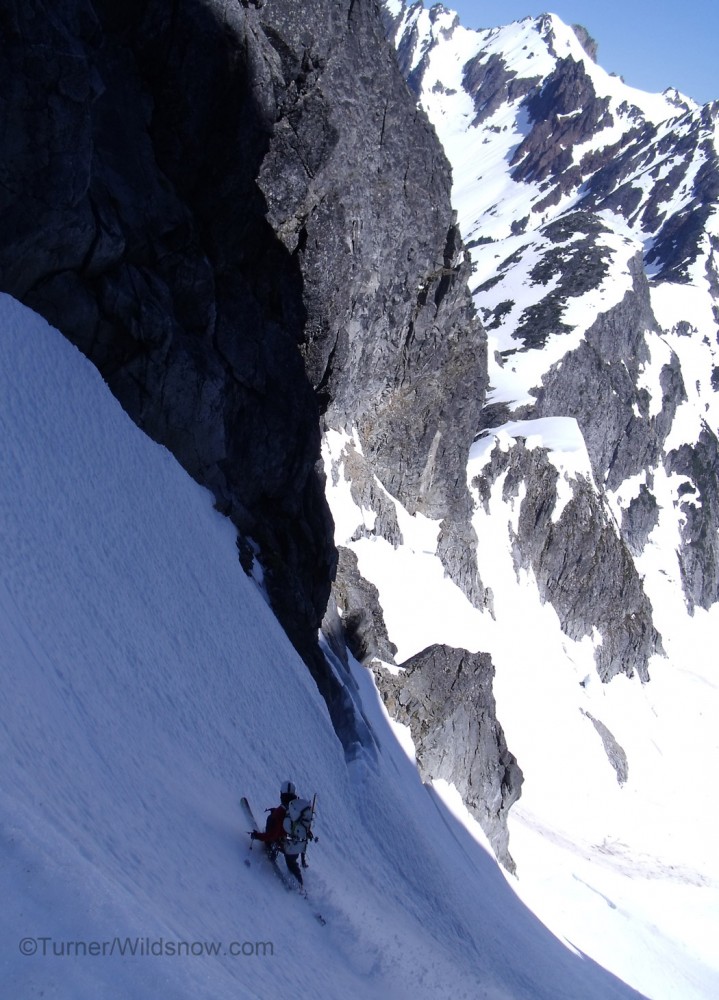
Skiing of Otto-Himmel col. The top was around 55 degrees, but it felt mellow compared to what we would encounter later in the day.
Up close with Thread of Ice
We were there, the base of the Thread of Ice! I didn’t have high hopes of being this successful on a first trip to the Pickets, but our luck held. The couloir looks pretty nondescript from the base since it winds through a wall of steep gneiss. Given all the shenanigans on the approach, we were a little later than expected, so we quickly transitioned and started booting up the couloir. The gully started out wide, but quickly narrowed and became quite steep. The Thread of Ice began living up to its name, with long patches of steep snow that were well on their way to becoming white ice. I was glad to have two tools.
We found a large vertical cornice at the top of the couloir and decided to ski from directly below it. The slope angle was the steepest I’d ever been on with skis, so we built an anchor in some rocks, and I proceeded to gingerly click into my skis. The slope was pushing 65 degrees, and the snow was hard enough that I wasn’t sure we could ski it. Kirk belayed me as I side-slipped the first section, which was sketchy, but it seemed we could make our way down. I built another anchor and belayed Kirk down to me. I then belayed Kirk past me and didn’t feel confident putting my skis back on and sliding down to him, so I set up a rappel. We both rappelled one full rope length down, then felt confident to stow the rope and attempt to ski.
We started tentatively sideslipping, with an axe easily accessible, but the slope angle continued to be uncomfortably extreme. I headed down for a few minutes and encountered some harder and steeper snow. I yelled up to Kirk that he might want to rappel this section, but I didn’t have that kind of choice. Plant axe, sideslip a few feet, plant axe, sideslip a few feet; this routine continued for a few harrowing minutes until I reached some boulders that had lodged in the snow.
Given the large chunks of rock and the sun-warmed gneiss above, perhaps it was not the best place to stop, but I was too tired to care. All I wanted was a spot where I didn’t have to precariously dig my edges in and use an ice axe to remain in place. I stood on the rocks for a few minutes as Kirk buried our “biodegradable” deadman and made a short rappel.
The snow was slightly softer here, and the slope angle eased up slightly too. It appeared we could turn! The first turn was a little nerve-racking, but it felt good to be in control, and we took turns jump-turning down the last 1/3 of the couloir.
We took shelter under a cliff at the base and ate a bit as we listened to rockfall pound the slopes around us. Thankfully none was directly on the remaining climb. We set off on crampons toward Otto-Himmel col. The climb went quickly, and soon we found ourselves once again at the col. We melted a bit of snow and again raided the mysterious stuff sack for some drink mix. It was comforting knowing all we had was one more couloir and then a quick climb to camp, so we took our time and enjoyed the afternoon light on the jagged Pickets.
Once recovered, we walked down some scree down to our last rappel of the day. We quickly got down to snow and partook in some creamy skiing. The snow had been softening in the sun all day and was slightly overcooked but incredible still. We had fun skiing the steep, narrow couloir.
We found some welcome liquid water at the base and began the long traverse toward camp. We switched to skins as darkness fell and ultimately to boots. Our melted-out snow wall was a welcome sight, as was the meal of sausage, cheese, and mashed potato we wolfed down. It was 11 by the time we finally reached camp: a 16-hour day. That’s the longest amount of time I’ve spent for so little vertical. The unexpected ropework had sucked up hours like a bad traffic jam.
The Path Home
We let the warm sun wake us up the next morning and spent a few hours drying out our gear and getting packed up. We weren’t too eager to get the bushwhack started. We made our way up the snowfield next to camp, and had a quick lunch at the top. Below us was a rolling sheet of perfect corn, a welcome sight. We carved down to the trees and were able to billy goat our way down a few hundred more vert before it became necessary to switch to hiking boots.
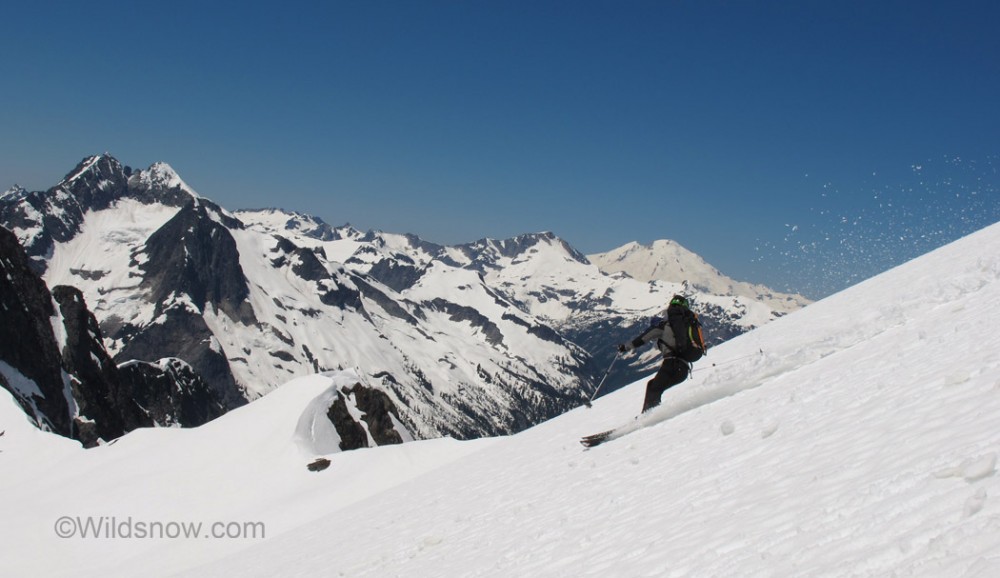
Kirk skiing the corn run on our way out. Our campsite can be seen next to the rock patch on the ridge on the lower left.
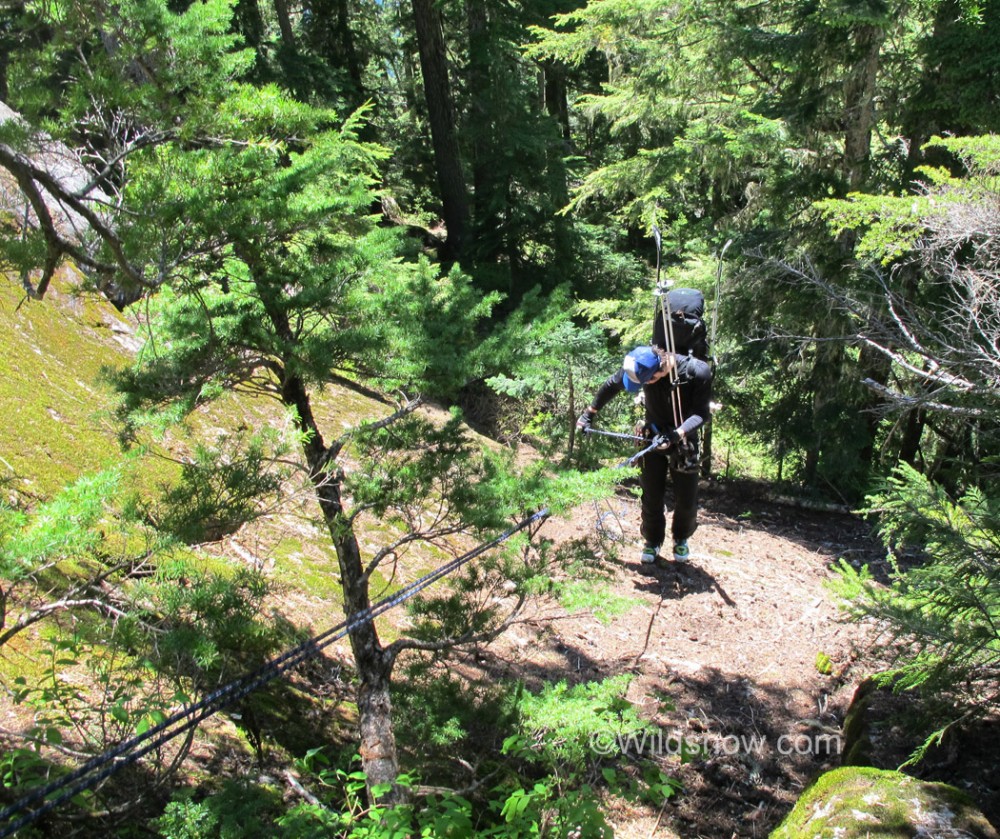
Final rappel of the trip, walking down a pine needle covered slab over a sizable cliff didn’t sound like much fun.
We made our way down the ridge, able to follow the trail no better than the way up. A small wooden arrow made of sticks pointed downhill towards Terror Creek. We kept our eyes out but inevitably walked right past it. After the brush started to get thicker, we finally decided to turn around and barely spotted the arrow on our second pass. I wasn’t excited about the steep descent, but we got it over with eventually without getting lost. We repeated the log shimmy across Terror Creek and reached the relatively well-used trail down the valley. The other creek crossings were noticeably swollen. The last one required another dicey slide across a skinny, rotting log that flexed more than a worn-out ski.
The parking lot came into sight a little before dark, and we thankfully threw down our packs and tore off our shoes and boots. The descent had taken just as long as the way up two days prior. As we drove back toward Bellingham, I could already feel myself getting sore. The 1800-calorie Triple Whopper on the way home didn’t help.
From the brutal approach to the incredibly jagged peaks to the unreal views, the legendary Pickets lived up to everything I’ve heard about them and more. Adding backcountry skiing spice, the Thread of Ice held a sufficient pucker factor. It can be good to push your limits sometimes, but now I think I’m ready for some mellow corn slopes. This proved to be one of the most memorable trips I’ve been on, and I hope to be back at some point, perhaps soon.
Louie Dawson earned his Bachelor Degree in Industrial Design from Western Washington University in 2014. When he’s not skiing Mount Baker or somewhere equally as snowy, he’s thinking about new products to make ski mountaineering more fun and safe.

